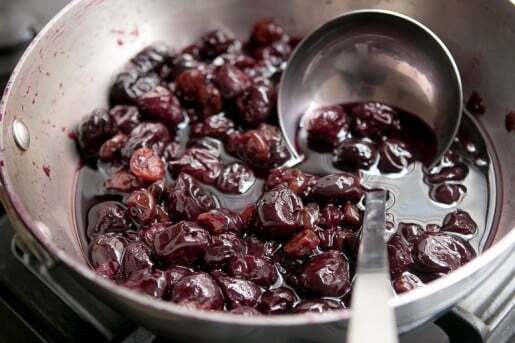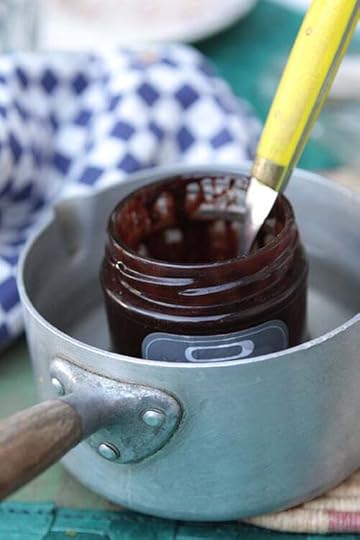David Lebovitz's Blog, page 2
November 11, 2024
French Apple Cake

It’s interesting how many views of Paris there are, which you notice if you follow the variety of voices that write about life in the City of Lights. (A mistake some writers make is to call it the City of Light, and ‘lights’ in actually plural.) I tend to find all the quirks and report on the sardonic side of things, which for some reason, always find their way into my life. But the main reason is that I live in Paris full time and don’t just get to sampe my way through the lovely pastry shops and meet chocolatiers, but like most Parisians, I also spend a fair amount of time wrestling with perplexing bureaucracy and other idioms of life in the City of Fight Light.
For example, last week I went to the largest fabric store in Paris where I always buy étamine (cotton gauze), which I couldn’t locate so I asked a salesperson to direct me there. He was having a nice chat with his co-workers but was kind enough to take a moment to tell me “Non”, they didn’t carry it…and went back to his conversation. After I raised an eyebrow and asked a few more times, just be sure, he and all the others in the group shook their heads, confirming with absolute certainty that they definitely did not have that in stock.
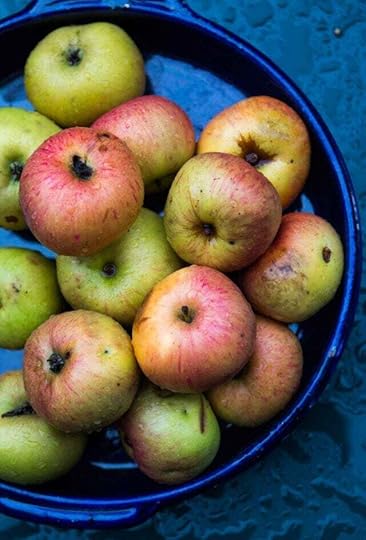
Because I was absolutely certain that they did, I went down one level and, of course, found a huge bolt of it right on top of the pile of other rolls of fabric. C’est comme ça…
Having a French partner helps, and he also helps me in the kitchen, like when Romain arrived with a bag of apples from a friend’s farm in Burgundy. Some were dinged up a bit, as they weren’t from the supermarché, but French apples are delicious for baking, where bumps and bruises magically disappear.
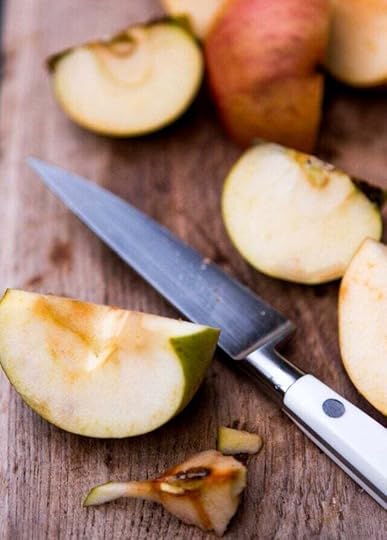
So to keep things in perspective (as best I can…) I like to read other voices from Paris, such as Dorie Greenspan, whose book, Around My French Table, is a hefty collection of her favorite recipes and stories about Paris. She lives on the opposite side of the city, in a different neighborhood. And where I am sometimes defeated by city life, as a “part-time Parisian,” as she often calls herself, she manages to see the good in everything.
This is a very typique French recipe for home cooks, made with not a lot of ingredients, relying on no special techniques or hard-to-find equipment, and loved by all. The cake is easily mixed up in a bowl, scraped into a cake pan, and in less than the time it takes to run to the pâtisserie for a store-bought cake—or a seemingly simple length of fabric—you can have an authentic French cake…right from your own oven.
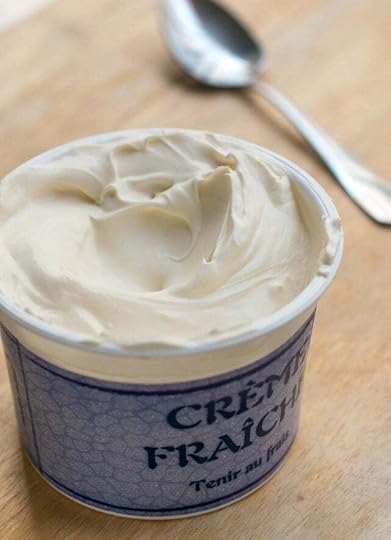
When a journalist interviewed me for an article about her, she ended the interview with; “So David, what is it like to sit around Dorie’s French table?”
I sat there for a few moments scratching my head to remember, then not sure of what to say, I finally replied, “I’ve not sat around Dorie’s French table.” Which was true. When she comes to Paris, we generally go out exploring. The idea of sitting indoors while Paris awaits just isn’t as interesting to me as sharing pastries on a park bench or hitting an outdoor market with her.
If you want to sit at Dorie’s table, the line starts here. However while you wait, you can feast on her recipes, just as I’m doing.
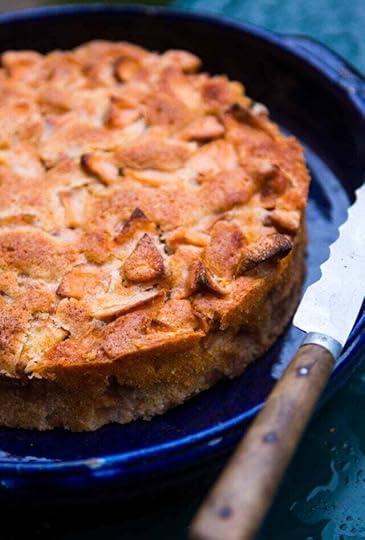
 PrintFrench Apple CakeAdapted from Around My French Table by Dorie GreenspanDorie doesn’t specify any type of apple but instead advises that you should use a mix of them. I don’t know what kind mine were since Romain brought them to me. The rum is really a great flavor in this cake, but if you’re avoiding alcohol, you could double or triple the vanilla to compensate. I also like this recipe because you can make it with ingredients easily on hand. Being American, I was tempted to add a dusting of ground cinnamon to the apples, but then it wouldn’t be authentically French. Hence I often decide to add a dollop of crème fraîche alongside, but it's wonderful just as it is.The original recipe uses a springform pan but if you don't have one, you can use an 8-inch (20cm) cake pan, buttering it well and lining the bottom with a circle of parchment paper before adding the batter. I've also make it in a 9-inch (23cm) cake pan and it works well, although it won't be a high.Course DessertCuisine FrenchServings 8 cakeIngredients3/4 cup (110g) flour3/4 teaspoon baking powderpinch of salt4 (about 2 pounds, 1kg) large apples a mix of varieties2 large eggs at room temperature3/4 cup (150g) sugar3 tablespoons dark rum1/2 teaspoon vanilla extract8 tablespoons (115g) butter salted or unsalted, melted and cooled to room temperatureInstructionsPreheat the oven to 350ºF (180ºC) and adjust the oven rack to the center of the oven.Heavily butter an 8-inch (20cm) springform pan and place it on a baking sheet.In a small bowl, whisk together the flour, baking powder, and salt.Peel and core the apples, then dice them into 1-inch (3cm) pieces.In a large bowl, beat the eggs until foamy then whisk in the sugar, then rum and vanilla. Whisk in half of the flour mixture, then gently stir in half of the melted butterStir in the remaining flour mixture, then the rest of the butter.Fold in the apple cubes until they’re well-coated with the batter and scrape them into the prepared cake pan and smooth the top a little with a spatula.Bake the cake for 50 minute to 1 hour, or until a knife inserted into the center comes out clean. It may take less time, depending on the apples, so check the cake 5 or so minutes before the recommended baking time. Let the cake cool for 5 minutes, then run a knife around the edge to loosen the cake from the pan and carefully remove the sides of the cake pan, making sure no apples are stuck to it.NotesServing: Serve wedges of the cake just by itself, or with crème fraîche or vanilla ice cream.Storage: The cake will keep for up to three days covered. Since the top is very moist, it’s best to store it under a cake dome or overturned bowl.
PrintFrench Apple CakeAdapted from Around My French Table by Dorie GreenspanDorie doesn’t specify any type of apple but instead advises that you should use a mix of them. I don’t know what kind mine were since Romain brought them to me. The rum is really a great flavor in this cake, but if you’re avoiding alcohol, you could double or triple the vanilla to compensate. I also like this recipe because you can make it with ingredients easily on hand. Being American, I was tempted to add a dusting of ground cinnamon to the apples, but then it wouldn’t be authentically French. Hence I often decide to add a dollop of crème fraîche alongside, but it's wonderful just as it is.The original recipe uses a springform pan but if you don't have one, you can use an 8-inch (20cm) cake pan, buttering it well and lining the bottom with a circle of parchment paper before adding the batter. I've also make it in a 9-inch (23cm) cake pan and it works well, although it won't be a high.Course DessertCuisine FrenchServings 8 cakeIngredients3/4 cup (110g) flour3/4 teaspoon baking powderpinch of salt4 (about 2 pounds, 1kg) large apples a mix of varieties2 large eggs at room temperature3/4 cup (150g) sugar3 tablespoons dark rum1/2 teaspoon vanilla extract8 tablespoons (115g) butter salted or unsalted, melted and cooled to room temperatureInstructionsPreheat the oven to 350ºF (180ºC) and adjust the oven rack to the center of the oven.Heavily butter an 8-inch (20cm) springform pan and place it on a baking sheet.In a small bowl, whisk together the flour, baking powder, and salt.Peel and core the apples, then dice them into 1-inch (3cm) pieces.In a large bowl, beat the eggs until foamy then whisk in the sugar, then rum and vanilla. Whisk in half of the flour mixture, then gently stir in half of the melted butterStir in the remaining flour mixture, then the rest of the butter.Fold in the apple cubes until they’re well-coated with the batter and scrape them into the prepared cake pan and smooth the top a little with a spatula.Bake the cake for 50 minute to 1 hour, or until a knife inserted into the center comes out clean. It may take less time, depending on the apples, so check the cake 5 or so minutes before the recommended baking time. Let the cake cool for 5 minutes, then run a knife around the edge to loosen the cake from the pan and carefully remove the sides of the cake pan, making sure no apples are stuck to it.NotesServing: Serve wedges of the cake just by itself, or with crème fraîche or vanilla ice cream.Storage: The cake will keep for up to three days covered. Since the top is very moist, it’s best to store it under a cake dome or overturned bowl.Related Posts and Recipes
June 12, 2024
paris restaurants (new updates)

I’ve been featuring some new and revisited favorite restaurants in Paris, writing them up in my newsletter. You can find a list of my Favorite Restaurants in Paris on my website but here are links to the posts in my newsletter of places I’ve eaten at lately…
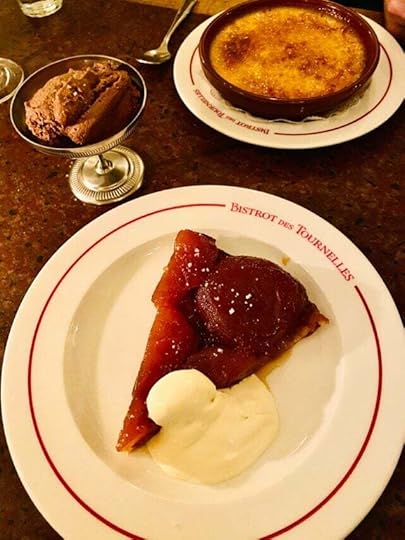 L’Amis Louis (for paid subscribers)New and Favorite Paris Addresses (February 2023)Bistrot des TournellesDes TerresCafé Les Deux GaresThe Best of Paris (April 2022)And if you’re gluten-free, check out The Real Emily in Paris’s Gluten-Free Guide to Paris.
L’Amis Louis (for paid subscribers)New and Favorite Paris Addresses (February 2023)Bistrot des TournellesDes TerresCafé Les Deux GaresThe Best of Paris (April 2022)And if you’re gluten-free, check out The Real Emily in Paris’s Gluten-Free Guide to Paris.To get more Paris tips (and stories and recipes) sent right to your Inbox, subscribe to my newsletter here:
June 5, 2024
Cherry Compote
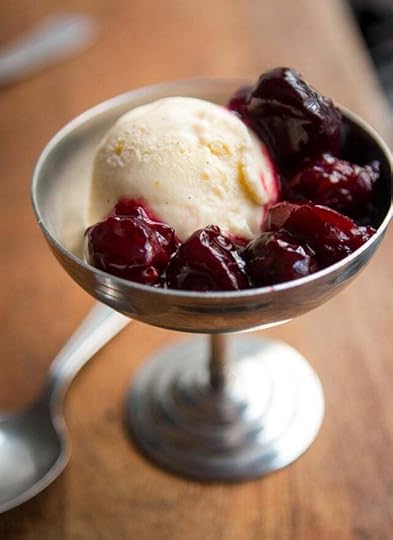
I think I have something wrong with me. I seem to be afflicted with a particular malady that forces me to buy way too many summer fruits when they’re in season. It gets particularly dire when faced with apricots and cherries, two fruits whose seasons are much shorter than the others. The first fresh apricots I saw were back in upstate New York, around the 1980s, and I’d never seen them before. Someone brought us a basket of the tender, squishy little orange fruits to the restaurant that I worked at, and I remember being completely taken off guard, as the only apricots I’d ever seen were the dried ones. And while I loved the crinkly dried specimens, those fresh beauties with a red blush were a whole other taste entirely.
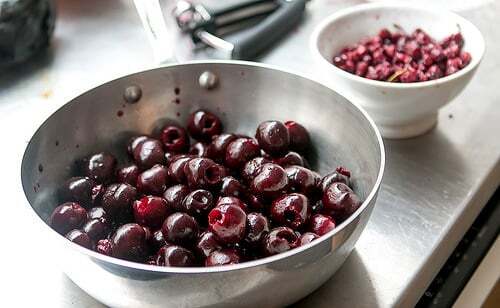
Then, when I moved to California, I discovered how abundant fresh apricots are (or can be), as they are in France. But no matter how abundant – or not – cherries are when the season is in full swing, I always consider them extra-special fruits and give a prominent place in my kitchen. At the beginning of the season, they’re incredibly expensive and rarely good. Then, as the season moves along, they start showing up in larger mounds at the market, and the prices get gentler, coaxing me to buy as many as I can heft.
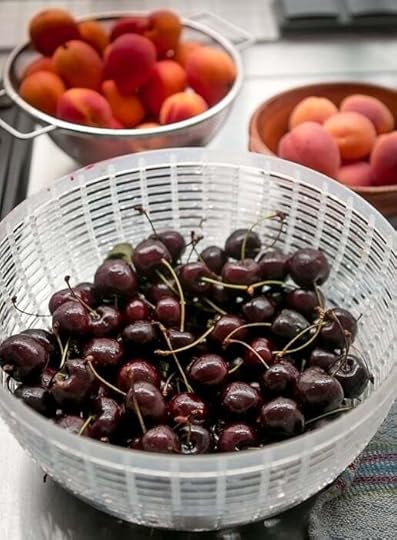
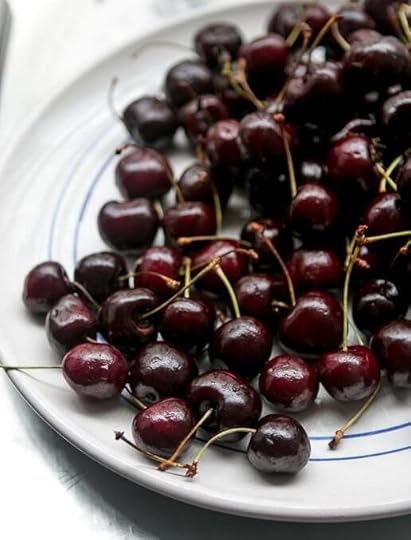
This week, I was helpless when faced with an overload of summer fruits at the market. And in addition to a giant bag of apricots, two bulging sacks of tomatoes, and eight white nectarines, I bought 2 kilos (about 4 1/2 pounds, give or take a few cherries) of fresh cherries — and from the looks of the other shoppers, it was more than any normal person would buy. (Although I think I made the vendor’s day.) But I couldn’t help it. They were Burlat cherries and I’d bought a small bag from the same vendor last week at the market, and there he was again, tempting me with more. Once I got home, I got my cherry pitter out, and pitted half of them, saving the others to eat fresh. (Except I almost polished off the fresh ones I was reserving as I was pitting these!)
Fresh cherries are, of course, great fresh. But cooking them can deepen, and even improve their flavor, especially nice if you get home and find yourself with a bag of rather wan ones. Or ones that you might snag at the end of the market, when the vendors are trying to get rid of any extras that might not keep until the next market day.
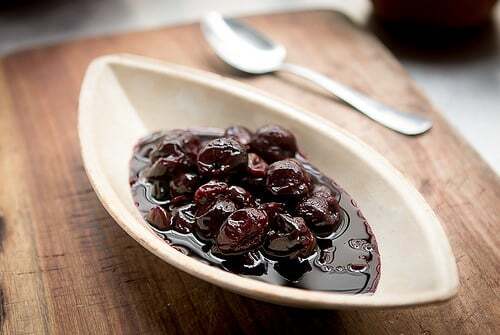
In addition to being the answer to what the heck you (or I) are going to do with all those cherries, this recipe also deftly answers that age-old question: Can I freeze that? And the answer is a big, resounding, “Heck, yeah!” Once the compote has cooled, it freezes perfectly in zip-top freezer bags or other containers that you prefer to use, and will last up to a year. (You can also freeze pitted fresh cherries on their own as well.)
And let me tell you, it’s great to stumble upon a bag of cherry compote that may have moved to an unfavorable position in your freezer as summer shifted into fall – or winter, when they can become quickly forgotten. Once defrosted, and perhaps rewarmed, they’re terrific served with vanilla ice cream, plain yogurt, or alongside a cake, such as almond cake, gâteau de savoie, or angel food cake.
I like to boost their flavor with a handful of dried sour cherries, added midway during cooking, so they plump up and absorb the cherry juices, which add another dimension of cherry flavor. A shot of kirsch also dials up the flavor nicely.
 PrintCherry CompoteBe sure to use a larger pot that you think. For 2 pounds (1kg) of cherries, I used a 6-quart (6l) pan. Since the cherry juices will foam up as they cook, using a larger pot – and removing the lid from time-to-time – will keep your from having to clean up a sticky mess.
PrintCherry CompoteBe sure to use a larger pot that you think. For 2 pounds (1kg) of cherries, I used a 6-quart (6l) pan. Since the cherry juices will foam up as they cook, using a larger pot – and removing the lid from time-to-time – will keep your from having to clean up a sticky mess.I’ve didn’t use much sugar here, so you can add more to taste, if your cherries aren’t as sweet as mine were. If you can get sour cherries, feel free to add some in place of the sweet cherries. If so, you may need to increase the sugar a little, to taste as well.Ingredients2 pounds (1kg) fresh cherries1/4 cup (50g) sugarcup (40g) optional: 1/3 dried sour cherries2 teaspoons kirsch (or another fruit-based liqueur, or eau-de-vie)1-2 drops pure almond extractInstructionsStem and pit the cherries. Put them in a large, nonreactive pot or saucepan and stir in sugar. Turn the heat to medium, cover, and cook for 10 minutes, lifting the lid and stirring them frequently, to encourage juicing and to make sure the liquid the cherries exude doesn’t foam up and overflow.After 10 minutes of cooking, add the sour cherries, if using, and cook for 5 to 10 more minutes, until the cherries are wilted and completely cooked through.Remove from heat and stir in the kirsch and almond extract. Let cool before storing or serving. The juices will thicken as the compote sits.NotesStorage: The cherry compote can be stored in the refrigerator for up to 5 days. It can be frozen for up to one year.
Related Recipes
April 19, 2024
Coconut Chocolate Macaroon Recipe
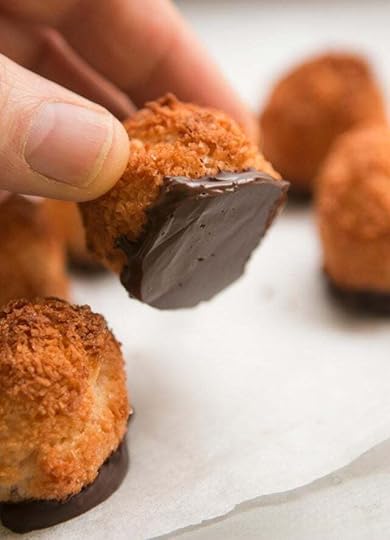
Many people tell me this is one of their favorite recipes from my cookbook, Ready For Dessert. In addition to these fantastic Coconut-Dipped Chocolate Macaroons in it, you’ll find the much-loved recipe for Fresh Ginger Cake, which makes a fantastic dessert served with sliced, juicy peaches or flavorful strawberries and raspberries in the summer, or tangy lemon cream in the winter, as well as my other most frequently requested recipes.
I’m often asked about the different between Parisian macarons and American-style macaroons, like these. Both are egg white-based, however the European version (which was invented in Italy) uses almonds whereas the American ones use coconut. There’s some dispute about how the American ones came to be made of coconut; one theory is that European immigrants who came to the United States couldn’t get almonds, or they were too expensive, so they used coconut.
Another theory is that European companies wanted to ship their macarons over longer distances, so swapped out coconut for the spoilage-prone nuts. Others credit Franklin Baker, an American flour miller, who found the then-exotic shredded coconut more interesting (and less-expensive) to use than nuts. Either way, I like all kinds of macaroons…or macarons.
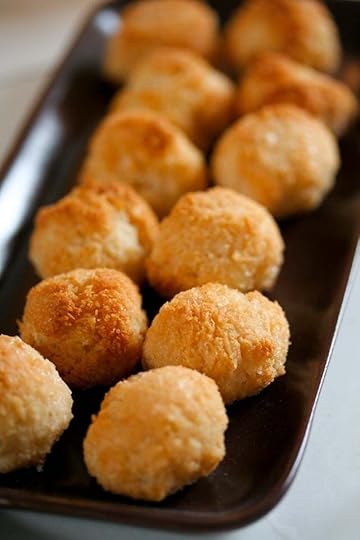
The French do make coconut cookies, which are called Congolais or Rochers à la noix de coco, usually shortened to Rochers coco, or coconut “rocks.” I’ve not seen them dipped in chocolate in any French bakery – but why not?

I’ve tweaked this recipe over the years and tested them with flour alternatives, which I’ve noted in the headnote in the recipe, and they come out great. You can even skip swiping the bottoms in bittersweet chocolate if you wish. No matter how you make them, I hope they become one of your favorite cookies, too.
 PrintCoconut and Chocolate MacaroonsFrom Ready for DessertI invariably make these cookies when I have extra egg whites on hand. The dough freezes beautifully if I don't plan to make the macaroons right away. These coconut macaroons can be made without the flour by substituting 2 1/2 tablespoons of cornstarch or potato starch for the flour. Readers have told me the recipe works well with 1/4 cup matzoh meal substituted in place of the flour. Course DessertCuisine AmericanKeyword coconut, cookie, macarooonServings 30 CookiesIngredients4 large egg whites1 1/4 cups (250g) sugar1/4 teaspoon salt1 tablespoon honey2 1/2 cups (200g) unsweetened shredded coconut (see note)1/4 cup (35g) flour1/2 teaspoon vanilla extract or vanilla bean paste3 ounces (90g) bittersweet or semisweet chocolate choppedInstructionsIn a large skillet or wide saucepan, mix together the egg whites, sugar, salt, and honey. Over low heat on the stovetop, stir the egg whites and sugar together until the mixture is tepid, but not warm or hot. You don't want to cook them; just warmed slightly so they are looser.Add the coconut, flour, and vanilla. Continue to stir the mixture over medium heat for a few minutes until it thickens to a cohesive mass. (It'll be like very thick oatmeal and the bottom will very slightly start to scorch.) Remove from heat. Transfer to a bowl to cool to room temperature.When ready to bake, line a baking sheet with parchment paper or silicone baking mat and preheat the oven to 350º F (180ºC).Form the dough into 1 1/2-inch (4cm) rounds in your hands, squeezing the dough to coax them into rough rounds (remember, the French call them "rocks," so they can be a uneven - for smoother rounds, dampen your hands), then place them evenly spaced on the baking sheet. Bake the macaroons until deep golden brown, about 18 to 20 minutes. Cool completely.To dip the macaroons in chocolate, melt the chocolate in a clean, dry bowl set over a pan of simmering water (or in a microwave.) Line a baking sheet with plastic wrap or parchment paper. Dip the bottoms of each cookie in the chocolate and set the cookies on the baking sheet. Refrigerate 5-10 minutes, until the chocolate is set.NotesUnsweetened shredded coconut is available in most natural food shops or you can purchase it online. Flaked coconut is larger and I haven't tried these macaroons with the flakes but if that's all you have, I would pulse the flakes in a food processor a few times until they're finely shredded.Storage: The baked macaroons will keep for up to three or four days if stored in an airtight container. If dipped in chocolate, store the cookies in a cool place. The dough can be refrigerated for up to one week or frozen for at least two months.
PrintCoconut and Chocolate MacaroonsFrom Ready for DessertI invariably make these cookies when I have extra egg whites on hand. The dough freezes beautifully if I don't plan to make the macaroons right away. These coconut macaroons can be made without the flour by substituting 2 1/2 tablespoons of cornstarch or potato starch for the flour. Readers have told me the recipe works well with 1/4 cup matzoh meal substituted in place of the flour. Course DessertCuisine AmericanKeyword coconut, cookie, macarooonServings 30 CookiesIngredients4 large egg whites1 1/4 cups (250g) sugar1/4 teaspoon salt1 tablespoon honey2 1/2 cups (200g) unsweetened shredded coconut (see note)1/4 cup (35g) flour1/2 teaspoon vanilla extract or vanilla bean paste3 ounces (90g) bittersweet or semisweet chocolate choppedInstructionsIn a large skillet or wide saucepan, mix together the egg whites, sugar, salt, and honey. Over low heat on the stovetop, stir the egg whites and sugar together until the mixture is tepid, but not warm or hot. You don't want to cook them; just warmed slightly so they are looser.Add the coconut, flour, and vanilla. Continue to stir the mixture over medium heat for a few minutes until it thickens to a cohesive mass. (It'll be like very thick oatmeal and the bottom will very slightly start to scorch.) Remove from heat. Transfer to a bowl to cool to room temperature.When ready to bake, line a baking sheet with parchment paper or silicone baking mat and preheat the oven to 350º F (180ºC).Form the dough into 1 1/2-inch (4cm) rounds in your hands, squeezing the dough to coax them into rough rounds (remember, the French call them "rocks," so they can be a uneven - for smoother rounds, dampen your hands), then place them evenly spaced on the baking sheet. Bake the macaroons until deep golden brown, about 18 to 20 minutes. Cool completely.To dip the macaroons in chocolate, melt the chocolate in a clean, dry bowl set over a pan of simmering water (or in a microwave.) Line a baking sheet with plastic wrap or parchment paper. Dip the bottoms of each cookie in the chocolate and set the cookies on the baking sheet. Refrigerate 5-10 minutes, until the chocolate is set.NotesUnsweetened shredded coconut is available in most natural food shops or you can purchase it online. Flaked coconut is larger and I haven't tried these macaroons with the flakes but if that's all you have, I would pulse the flakes in a food processor a few times until they're finely shredded.Storage: The baked macaroons will keep for up to three or four days if stored in an airtight container. If dipped in chocolate, store the cookies in a cool place. The dough can be refrigerated for up to one week or frozen for at least two months.
October 22, 2023
Bourbon-Ginger Pecan Pie
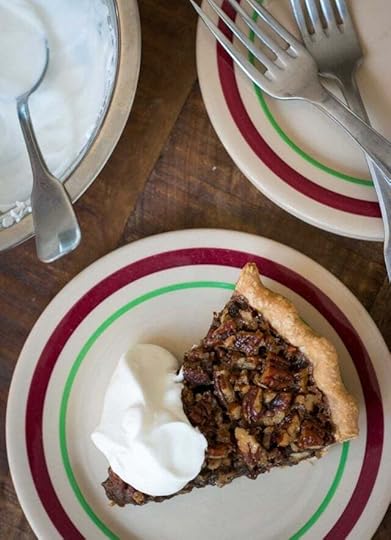
I wasn’t planning on beginning this post for a pie recipe with anything other than a story about how much I liked it, encouraging you to make it. (Which I’ll get to later.) But after I had started writing it, several neighborhoods in Paris came under attack, including mine, and I put everything on hold.
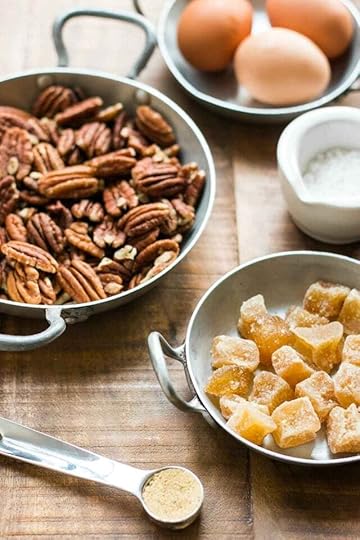
Cafés and restaurants that I knew, and areas that I frequent, were targets, as was the area around the theatre where my outdoor market is, which suffered the worst of it. Everyone I know is okay, but others were not so fortunate. It’s a crazy world we are living in and often we just see it on television and switch the channels to something more entertaining, so we don’t have to think about it. But when it happens right outside your door, or in a city that you love so much (whether you live there or are just an occasional visitor), you can’t avoid the shock and the grief. In addition to some introspection, my hope is that this will bring a conversation and dialogue that will somehow address why – and how – this happened, and where to go from here.
Continue Reading Bourbon-Ginger Pecan Pie...
September 18, 2023
Salted Butter Chocolate Sauce
When it comes to baking and desserts, one doesn’t necessarily think of salt as a flavor. But more and more, I keep considering, and reconsidering, the role that salt plays in just about everything I bake. And because I keep both salted and unsalted butter on hand – I can’t imagine my morning toast without a little salted butter spread over the top – I’ll sometimes reach for the salted variety when tackling a baking project or making dessert.
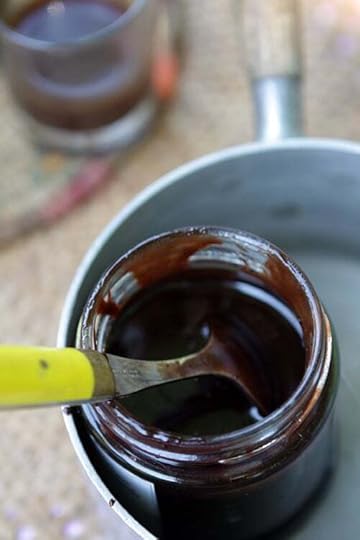
I wasn’t the first person to put salt on dessert; people from various cultures have been sprinkling salt on fresh fruit for ages. And many pastry chefs, as well as some big chocolate companies, have gotten in on the “salt in chocolate” act as well.
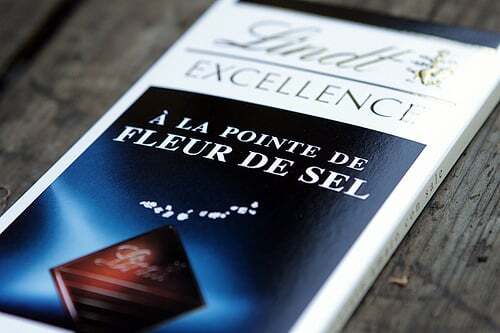
But I’ve gotten so used to sprinkling it on sweets that sometimes if I’m having my last course in a restaurant and I think the dessert needs a little perking up, you’ll find me looking around the table for a little bowl of flaky sea salt. Salt is so important to me that I’ll sometimes carry a little wooden box of fleur de sel, which when I’d bring out in restaurants, my co-diners would give me a look as if I was being pretentious. (Then – of course – they’d ask if they could have a pinch too.)
Continue Reading Salted Butter Chocolate Sauce...
June 18, 2023
Summer Fruit Tart with Almond Cream


This is one of the simplest fruit tarts to make. Juicy fruits are embedded in a rich almond frangipane, making it easy to slice, and it keeps well, too. So now that we’ve got that out of the way, let’s talk about nectarines.

Peaches get a lot of press. Yes, they’re juicy and yes they’re sweet. But honestly, I prefer the more assertive flavor of nectarines, with their slightly tooth-resistant skin, just enough to provide contrast to the juicy flesh, but not enough to make them necessary to peel. Yay for that as well.
Continue Reading Summer Fruit Tart with Almond Cream...
June 7, 2023
Summer Fruit Galette


Being a baker, summer is my favorite time of year. Not only are peaches, nectarines, cherries and plums abundant at the market, but as the seasons progress, the volume of fruits lowers the price, and I stock up on whatever I can, whenever I can.
At Paris markets, I try to search out producteurs, the vendors who grow the food they sell, and every summer, one in particular shows up at my market with lots of Reine Claude and mirabelle plums, a few different varieties of cherries, plump melons that you can smell standing a few feet away, tender figs, and fresh apricots.
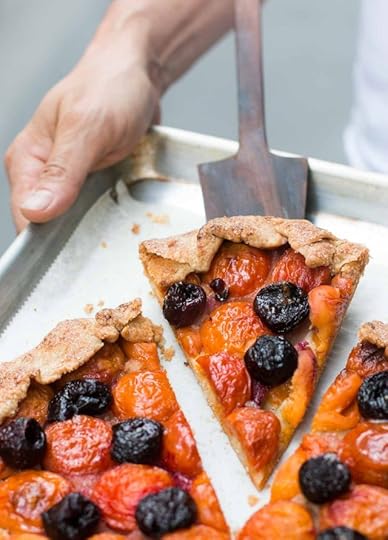
Making the shopping experience even better, were the fellows who sold the fruits. Not only were they easy on the eyes, but they often put punky-looking cherries in baskets, labeling them “for clafoutis” (a nicer way of saying “for baking”) and selling them at a reduced price. This year, there seems to have been a turnover in staff – zut – but the replacements also offer up the imperfect fruit, or even an overload, at a discount.
Continue Reading Summer Fruit Galette...
February 14, 2023
what ice cream maker to buy?
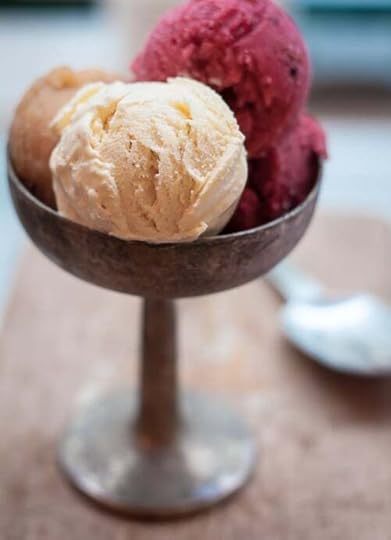
Everybody loves ice cream, and now more than ever, it’s easier to make ice cream, sorbet, and frozen yogurt at home. While people have been making ice cream before the advent of electricity (so yes, you can make ice cream without a machine), there are several options in various price ranges that make the job easier, with results that your friends and family will love.
There are a few options to consider when buying an ice cream maker, but rest assured there’s one that’ll fit every budget. I’ve got additional information in my book, The Perfect Scoop, the best-selling guide to making ice cream at home, but here is some additional information about the various ice cream machines that are available to help you make your decision.
(Note that this post contains affiliate links and I may receive a small commission if you make a purchase using a link from this page.)

My first machine with a built-in compressor was Cuisinart ice cream machine, which I used for over a decade with very good results. That model (the ICE-50) had few features and their latest model is the Cuisinart ICE-100 which I haven’t used. The ICE-50 was a sturdy workhorse, which was loud, but churned out a lot of ice cream for me in the two decades that I owned it. I also used it for developing and testing the recipes in The Perfect Scoop.

I recently purchased a Breville Smart Scoop machine, which comes with more options, and also comes at a higher price point than the Cuisinart machine. It offers the ability to pre-cool the machine, change speeds, and will keep the ice cream frozen after churning, if you want to serve later.
Outside of the U.S., these machines are sometimes sold under the Sage brand. I got mine on Amazon (France) during a flash sale when they were half price and I’m really enjoying using it. It’s a lot quieter than my previous Cuisinart machine and has several helpful options, including the ability to pre-chill the churning chamber, and you can set the firmness of your frozen dessert, from frozen yogurt and gelato, to sorbet and ice cream.
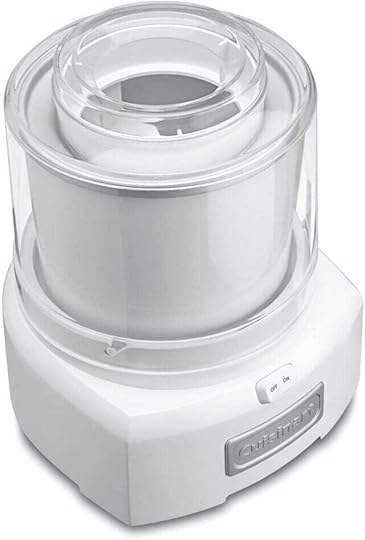
A lower priced option is a machine where you pre-freeze the canister 24 hours in advance before churning, so it requires a little patience, and sufficient freezer room, if you use one.
The upside is the price. These types of machines cost less than $100 (at the time of this writing, the machine above is selling for $69), and machine makes great ice cream as well as being affordable. Krups makes a similar machine, as does Hamilton Beach. (Hamilton Beach also makes a large capacity machine, that lets you freeze 4 quarts at a time, but requires you to add ice and rock salt. White Mountain, founded in 1853, also makes large-capacity machines that require ice and rock salt, and come in both electric and hand-cranked models.)

KitchenAid Ice Cream Maker Attachment
If you have a KitchenAid mixer, their excellent KitchenAid Ice Cream Maker Attachment works very well. I’ve used one extensively and it churns ice cream quickly, and you can adjust the speed easily.
Like other machines that don’t have a built-in compressor, you need to pre-freeze the canister at least 24 hours before you plan to churn your ice cream. So make sure you’ve got the freezer space for it.
Note: If you live outside the United States, KitchenAid mixers have different safety features and the U.S. ice cream attachment may not be compatible with them.
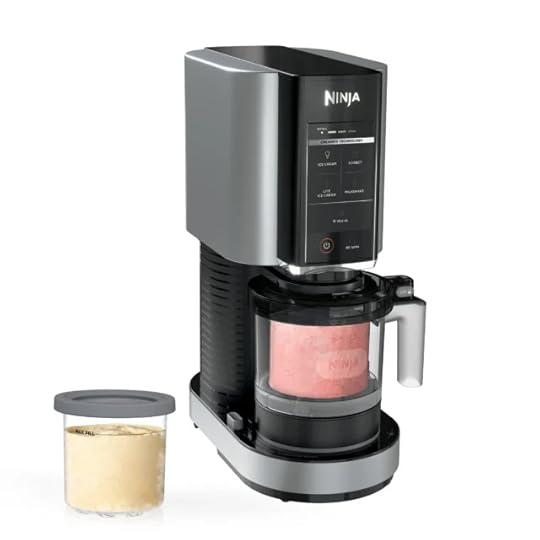
A new kid on the block is the Ninja Creami ice cream maker. Unlike traditional ice cream churning machines, this one works on the same principle as a Pacojet, a pricey machine used by professionals that can cost up to $8000! In these machines, you freeze the base in a pint container overnight, then place it in the machine and a rotating blade shaves the ice cream into a scoopable mass. The Ninja machine costs around $200 and although I haven’t used one, from what I’ve read people are happy with the results.
You can also find more of my recommendations for machines and ice cream making equipment, as well as recipes for all your favorite ice creams, sorbets, granitas, toppings, swirls, and more in my book, The Perfect Scoop, revised and updated!
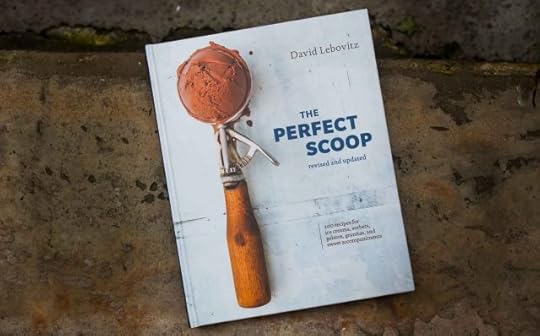
How to buy an ice cream maker

Everybody loves ice cream, and now more than ever, it’s easier to make ice cream, sorbet, and frozen yogurt at home. While people have been making ice cream before the advent of electricity (so yes, you can make ice cream without a machine), there are several options in various price ranges that make the job easier, with results that your friends and family will love.
There are a few options to consider when buying an ice cream maker, but rest assured there’s one that’ll fit within most budgets. I’ve got additional information in my book, The Perfect Scoop, the best-selling guide to making ice cream at home,but here is some additional information about the various ice cream machines that are available, to help you make your decision.
(Note that this post contains affiliate links and I may receive a small commission if you make a purchase using a link from this page.)

I’ve used a Cuisinart ice cream machine with a built-in compressor for over a decade with excellent results. Their latest model, the Cuisinart ICE-100 produces great ice cream and the price is right for a self-refrigerating machine. The great thing about a machine with a built-in compressor is that you don’t have to pre-canisters; you can churning your ice cream or sorbet as soon as it’s chilled!
One downside is that some people find the noise bothersome. But it is a machine and machines do make noise. (I’m still waiting for someone to make a noiseless vacuum cleaner!) To minimize noise, keep it in another room when churning ice cream.

The Breville Smart Scoop machine comes with more options, at a higher price point. It offers the ability to pre-cool the machine, change speeds, and will keep the ice cream frozen for up to three hours. Outside of the U.S., these machines are sometimes sold under the Sage brand.

A lower priced option is a machine where you pre-freeze the canister 24 hours in advance before churning, so it requires a little patience, and sufficient freezer room, if you use one.
The upside is the price. These types of machines cost less than $100 (at the time of this writing, the machine above is selling for $69), and machine makes great ice cream as well as being affordable. Krups makes a similar machine, as does Hamilton Beach. (Hamilton Beach also makes a large capacity machine, that lets you freeze 4 quarts at a time, but requires you to add ice and rock salt. White Mountain, founded in 1853, also makes large-capacity machines that require ice and rock salt, and come in both electric and hand-cranked models.)

KitchenAid Ice Cream Maker Attachment
If you have a KitchenAid mixer, their excellent KitchenAid Ice Cream Maker Attachment works very well. I’ve used one extensively and it churns ice cream quickly, and you can adjust the speed easily.
Like other machines that don’t have a built-in compressor, you need to pre-freeze the canister at least 24 hours before you plan to churn your ice cream. So make sure you’ve got the freezer space for it.
Note: If you live outside the United States, KitchenAid mixers have different features and the U.S. ice cream attachment may not be compatible with them.

A new kid on the block is the Ninja Creami ice cream maker. Unlike traditional ice cream churning machines, this one works on the same principle as a Pacojet, a pricey machine used by professionals that can cost up to $8000! In these machines, you freeze the base in a pint container overnight, then place it in the machine and a rotating blade shaves the ice cream into a scoopable mass. The Ninja machine costs around $200 and although I haven’t used one, people are happy with the results.
You can also find more of my recommendations for machines and ice cream making equipment, as well as recipes for all your favorite ice creams, sorbets, granitas, toppings, swirls, and more in my book, The Perfect Scoop, revised and updated!


